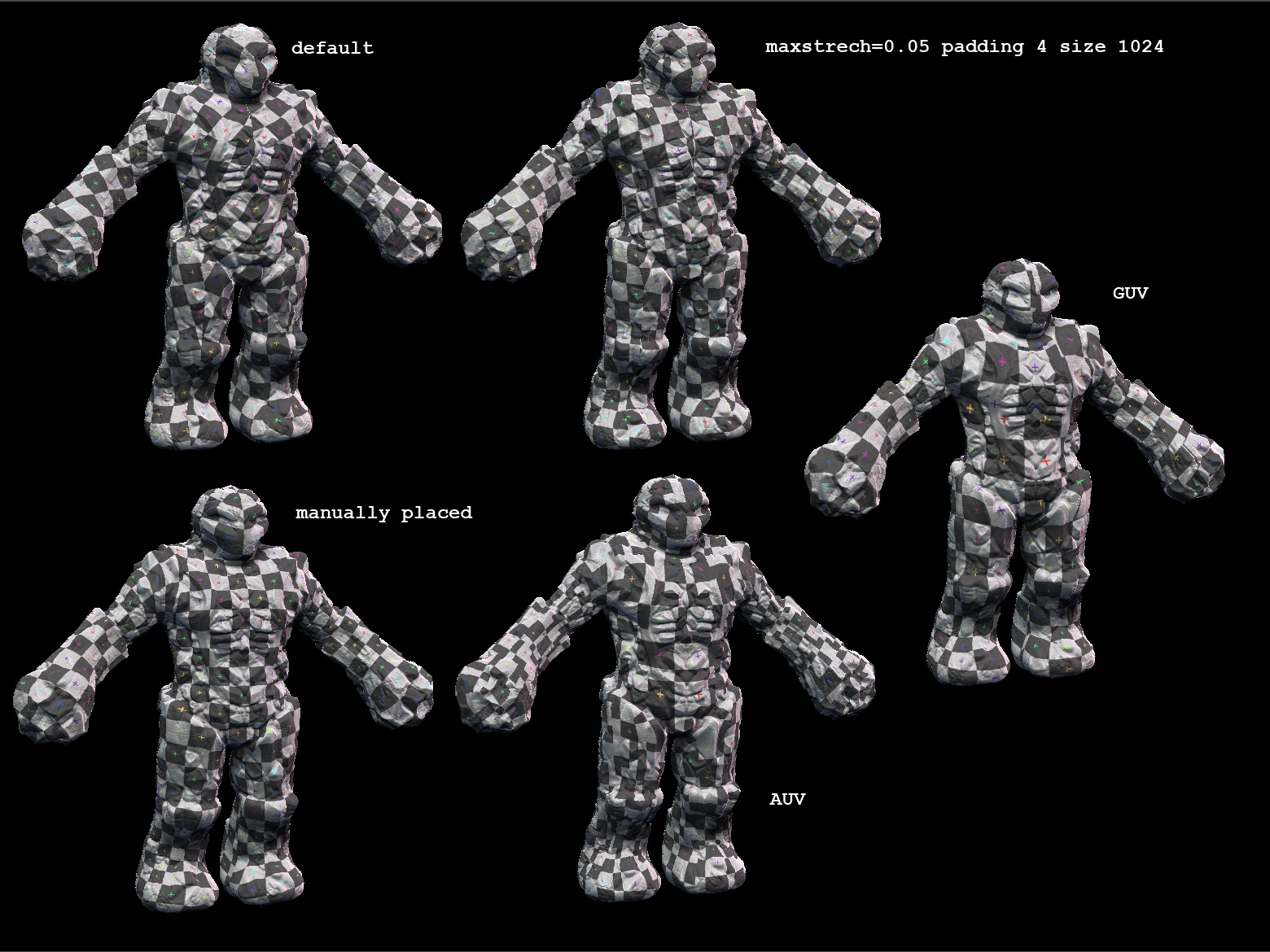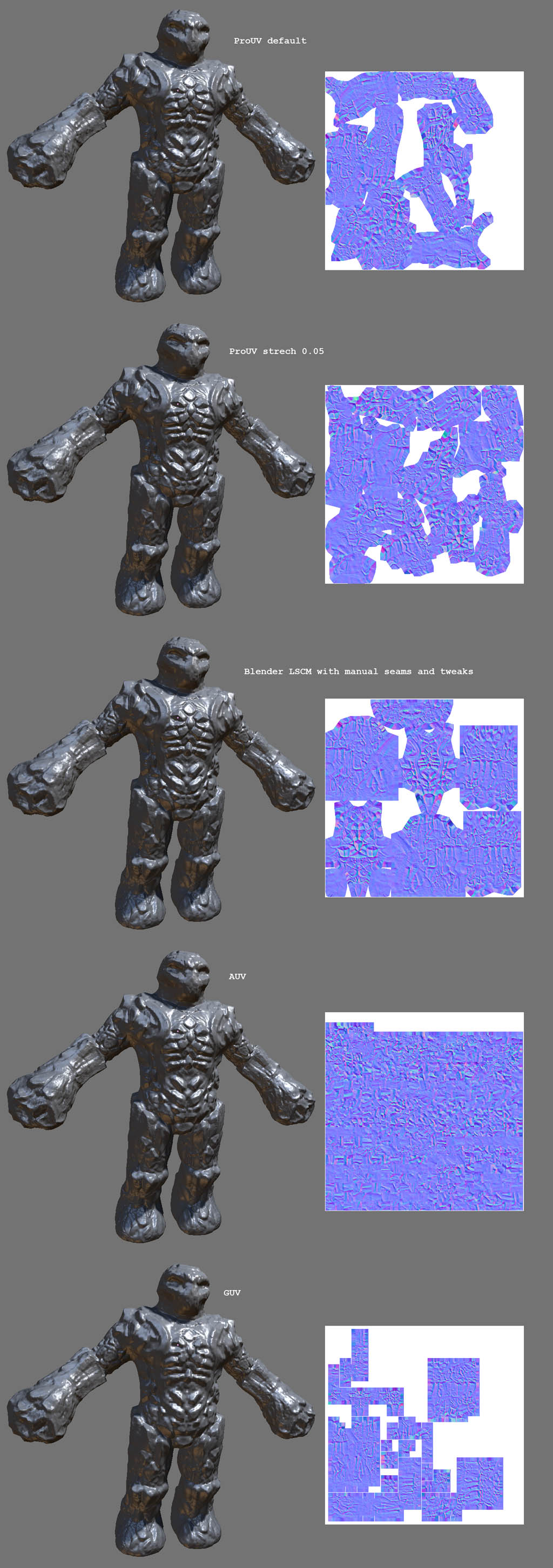This plugin is pretty nice. I tested it earlier by doing some poly painting, then exporting the obj and texture out, and loaded it all up in Lightwave. Everything worked just fine.
Too bad the beta expires later this month.
This plugin is pretty nice. I tested it earlier by doing some poly painting, then exporting the obj and texture out, and loaded it all up in Lightwave. Everything worked just fine.
Too bad the beta expires later this month.
No worries, the final v1.0 release will be available until that date (barring any serious bugs which need fixing cropping up in the last moment).
ps. I’ve put a new comparison on the home page: normal mapping with external rendering - click on the image to see it in full size.
done some tests myself on a full character just to see how it held up with normalmaps using blenders glsl shaders.
the default settings might have a bit to much stretching going on but after some tweaking it actually looks quite good i still prefer the one i did manually in blender tho but for just a single click not to bad


Great stuff, its holding quite good compared to boring manual unwrapping!
Hope it will save you some significant time which you would spend on such technical non-creative tasks. 
I don’t know if this is a bug or not, but even though I set my texture size to 2048x2048, it always comes out as 1024x1024.
you need to create a blank texture before by going into the texture palette and set the size there and press new to get any other size than 1024 when you crate a normalmap or transfer your polypaint to a texture
There will be a Mac version as well ?
The .ProUV.exe says it cant find ZB3 installed on my machine, ahtough it resides in default location:
C:\Program Files\Pixologic\ZBrush3
Does anyone know why it gives me the error?
thanks,
Herb
@florencepapillon: Not in the first version. Depending on the user demand, I might do it later during the year. Perhaps you could use it via parallels?
I was surprised at how well this worked. It gave us UVs that one could actually paint on in PS. I guess the only thing we don’t have direct control over is the location of the seams. It takes a human eye to decide where to place a seam. I’ll keep using the beta for the next few days and see how it performs. So far so good though. Good work.
Cheers, glad to hear it is useful! 
Direct seams control will be coming along in the future versions. What do you think about seams setup via poly-groups? Would it work? Or is there a better way for the artists to define them inside ZBrush?
I’m currently doing the licensing system, which is btw. soo boring to do… :o
I was thinking about that, actually. Of course, I’m a pretty novice user compared to some of the artists around here, but I suspect polygroups would be a good place to start, since that at least gives control to the user in a way that is already familiar to them. The challenge after that would still be in controlling where to place the actual seem. For example, if an arm is “ProUV-ed” according to its polygroup, will the seem run along the bottom of the arm starting at the armpit? The program doesn’t even know it’s an arm! Certainly a edge-selection method would help, but then it’s no longer an automatic task.
Maybe there can be an option to “offset” the seem by a percentage, 0% and 100% being essentially the same placement. Using a slider for that percentage would then dynamically move the seem “around” on the mesh. But then… you’d need a way of displaying the seem dynamically so we could see where it was.
On the other hand, one could argue that since texture-painting still relies so much on tools like PS, manually defining UV seems must remain part of the workflow.
I dunno. We all want to skip the UVing process entirely, of course. But it’s just a nature-of-the-beast kind of thing right now. I like where the ProUV plug-in is going, and I’ll be watching it closely.
What do you think about simply forcing seams to be on the places where two polygroups meet, and where no polygroup is defined at all means the seam is not allowed?
Sounds like a possibility, but it might interfere with existing polygroups, which are handy for selection purposes. Still, an option.
very nice!
it would be great if you could recognize that the models with symmetrical topology or similiar topologies repeated, that way you could copy and paste textures meaningfully in 2d. i.e. paint have a body and mirror the paint easily.
Just to let all interested people know, the open beta has been extended until 17.06.2009 - please download and install the latest Beta 3 release.
Beta 3 change-log can be found here.
Thoughts regarding enabling the user to define seam locations:
The Problem:
The purpose of providing user control over seam locations with this plugin would presumably be to address the fact that algorithmic seam selections are likely to be less ideal than user selections. The trick is in providing sufficient control to the user without loosing the “automatic” component/advantage of the tool.
A possible solution:
First - in my view, no uv solution would be complete without providing the user the option of 100% manual control over every uv of the uv layout, in a way that enables the user to powerfully mix manual and automatic solutions in ways that compliment each other, and to whatever extent the user feels necessary. It is very likely that such control will be preferred or even required at one point or another in any given production.
Having said that - a happy medium might be found in leveraging Zbrush’s painting abilitities. You could set up a workflow that would allow the user to indicate the start, end, direction and even mid-way guides for a seam via short paint strokes.
To illustrate:
If I were cutting the seam that separates an arm from the body - I could press a hotkey that indicates that the I’m about to mark the beginning of a cut, which I do by placing a simple dot with the paint brush. Next, I hold another hotkey to indicate that I’m about to mark the direction of the seam, which I describe by placing a stroke over a short distance, that over its length indicates the vector/direction of the loop. Then, I use a similar procedure to indicate the end of the cut, if I want it to end anywhere except the seam start position. Finally, I hit the unwrap button, and have the unwrap algorithm place cuts wherever I indicated, and additional cuts wherever it deems necessary (unless I mark a checkbox indicating that it should only make seams where I indicate). Color-coded marks, and other features that compliment and enhance this approach would also be nice.
Anyway, there’s one idea.
Yeah Francis that would be a solution but i guess it will be impossible
for one person to script all that into zbrush.
Also i think you will have a hard time publishing this as a plugin
that costs. So far i have seen no zplugin that had a price.
Also you have to keep in mind that z4 is infront of the door and all this
will most likely not work within it.
Not to speak of the possible new uv tools in z4.
Im guessing they came to similar ideas like the one Francis wrote here.
The main problem of this automatic unwrap is the seams and orientation
of the uv tiles. Sure with polypaint this works rather well but polypainting
is no industry standard. Photoshop on the other hand is. Now with a seam
over a visible section it will become a nightmare to paint seamless.
@Francis: Great idea! I’m actually thinking of doing something like that for the next version. 